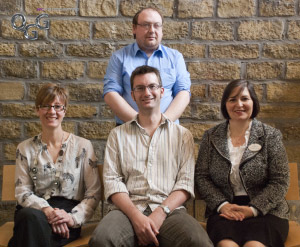The University’s supercomputer Sol
Thu, 25 Oct 2012 12:11:00 BST
The University's new 256-core computer cluster is now switched on

RESEARCHERS at the University of Huddersfield have direct access to more computing power than ever.
It means that key projects can come to fruition more quickly and the extent to which facilities are closely tailored to the needs of users is proving an important factor in attracting high-calibre researchers to the University.
Its High Performance Computer Research Group (HPCRG) has presided over the installation on campus of a new 256-core computer cluster, named Sol, available to users throughout the University. Calculations that would have taken weeks or months on a desktop machine can now be carried out in hours. Cutting-edge research in fields such as molecular biology, particle physics, fluid dynamics, computational chemistry, image rendering and informatics is reaping the benefit.
The new super computer – valued at £100,000 – is the latest in a series of key developments that have gathered pace since the HPCRG was formed in 2010, with representatives from various schools and departments. The goal was to provide a university-wide approach to high-performance computing. The Queensgate Grid was created to bring the various HPC resources under one umbrella and make them available for researchers across all schools.
 Then the HPCRG became an associate member of the National Grid Service and the Northwest Grid for high performance computing. It also forged a strong partnership with the Science and Technology Facilities Council so that it has access to the processing power of facilities at the Daresbury research centre, which are particularly suited to large and complex calculations.
Then the HPCRG became an associate member of the National Grid Service and the Northwest Grid for high performance computing. It also forged a strong partnership with the Science and Technology Facilities Council so that it has access to the processing power of facilities at the Daresbury research centre, which are particularly suited to large and complex calculations.
Pictured (l-r) Joanna Radley, Dr Paul Elliott (seated), Dr David Cooke and Dr Violetta Holmes.
Further expansion
Core members of the HPRCG are chemistry lecturers and researchers Dr Paul Elliott and Dr David Cooke, engineering and computing specialist and group leader Dr Violeta Holmes and Joanna Radley, who is Data Centre, Infrastructure and Network Services Manager.
But the group has rapidly grown in size and scope and there are currently at least 100 researchers – academic staff and students – using the enhanced high performance computing facilities now available. Demand is growing and within days of its launch, the new Sol computer cluster was being used to 76 per cent capacity, so that the HPCRG is already considering plans for further expansion.
Software has been developed to create an intelligent scheduling system which automatically manages access to high performance computing facilities.
“We have a queue of jobs that have been submitted from researchers in applied sciences, informatics, engineering and elsewhere, and they are currently managed on a first-come first-served basis, but there are also other, more intelligent techniques in development that can be used for better utilisation of the resources,” said Dr Holmes.
Cross-fertilisation
A distinctive feature of high performance computing at the University of Huddersfield is that it is collaborative in nature, with no single school or department claiming ownership. It was decided that a collective approach would make more sense, said Joanna Radley.
Dr Holmes claims that the University of Huddersfield’s philosophy of sharing resources in this way has made it unique and that this adaptability and cross-fertilisation leads to benefits in research. It also acts as a powerful recruiting tool and was one of the factors that drew the research chemist Dr Pooja Panchmatia (pictured below) to the University.
“Other universities will invest in a computer and then charge research groups to use it. But at Huddersfield we are putting in a donation from our research funding and we really feel that is our machine,” she said.
 Dr Panchmatia added that it was important to ensure that there was greater awareness in the wider academic and research world of the facilities now in place at Huddersfield. One element in this was a first annual HPCRG research day, which featured talks from members of the group on the high performance computing resources available to researchers at the University. There were also talks from staff and students who utilise high performance computing for their research in fields such as computational chemistry, physics and engineering.
Dr Panchmatia added that it was important to ensure that there was greater awareness in the wider academic and research world of the facilities now in place at Huddersfield. One element in this was a first annual HPCRG research day, which featured talks from members of the group on the high performance computing resources available to researchers at the University. There were also talks from staff and students who utilise high performance computing for their research in fields such as computational chemistry, physics and engineering.
The research day also celebrated the switching on of the 256-core Sol cluster and marked the official opening of the HPCRG’s Visualisation Suite. It is equipped with large, state-of the-art screens that are ideal for the display and analysis of 3-D and X-ray images. There are also video conferencing facilities – including high-end speakers and cameras embedded in the ceiling – which will enable research to be discussed on a global level – there has already been a Skyped conference linking Huddersfield and Chicago.
Dr Elliott stresses that the HPCRG’s facilities, made available to researchers throughout the University, will have real world benefits.
“The calculations and the modelling that we can do will lead to improvements in many areas of science and technology, such as batteries, super conductors, solar cells, light emitting materials, biomineralisation and improved aerodynamics so that vehicles can reduce fuel consumption.”







